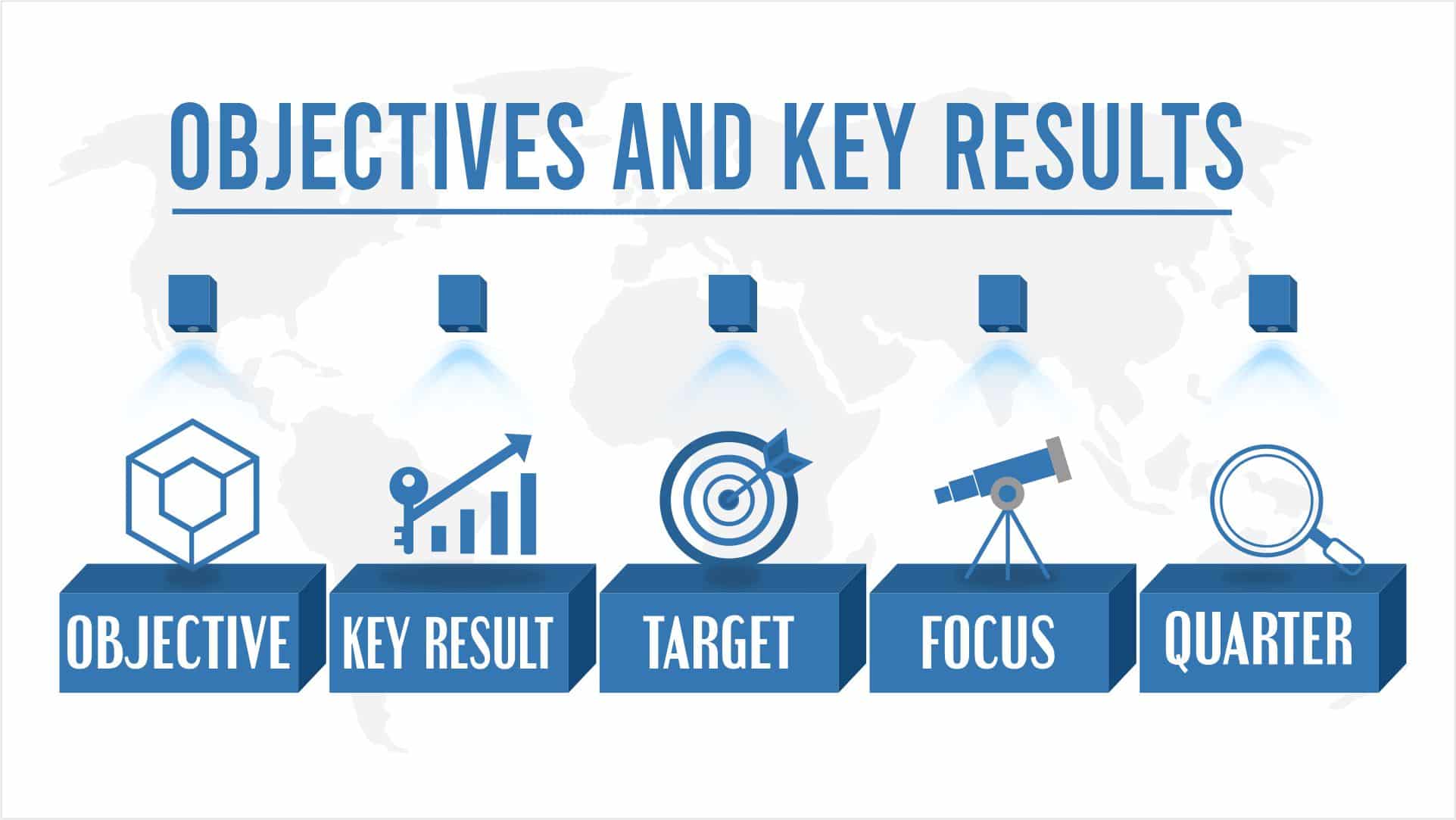SMART Goals Examples For Work [Guide For Professionals With Templates]
As we step into the fresh year of 2024, it’s time to set resolutions for both our personal and professional lives. This includes taking a close look at our business plans and practices to ensure they are up-to-date and equipped to keep us ahead of the competition. The fast-changing landscapes of the business world make it necessary for us to keep up with the upcoming trends. Professionals should consider SMART goals examples for work to set the tone for the year.
Every other business is prioritizing effective strategy and goal planning for their growth. Hence, it is about time to take all the learning from the last year and set realistic and achievable goals for next year. But how do we ensure that we have set our goals appropriately? Goal setting is part art and part science that sets us and our business up for success and makes it easier to measure our progress. We can employ a simple yet powerful SMART goal method to create practical goals to ensure that our goals are realistic and we make the most of our time and resources.
In this blog, we will discuss in detail what are smart goals, their types, and how you can create smart goals for better planning. We have also discussed some SMART goals examples for work and Templates to help you start with.
What Are SMART Goals?
SMART goals remove ambiguity and are used to set a plan to track your performance without missing any deadlines. A SMART goal is an acronym for Specific, Measurable, Achievable, Realistic, and Timely goals. Therefore, SMART goals incorporate all of these criteria to help focus your efforts and increase the chances of achieving your goal. Let’s discuss the key characteristics of SMART Goals:
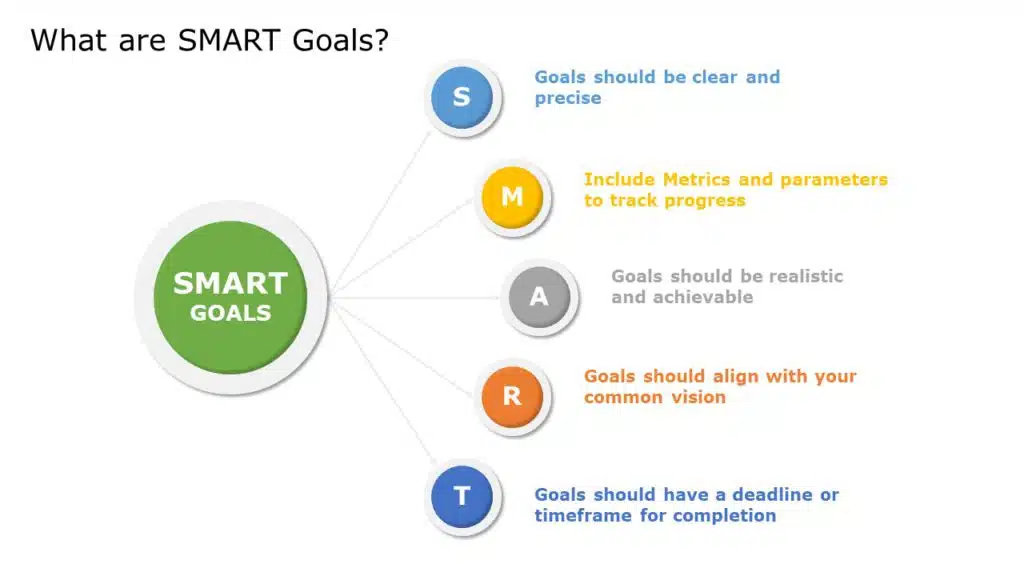
Specific: It means that your Goals should be clear and precise. Define precisely what you want to achieve. Use Professional language and ensure everyone understands the objective.
Measurable: Your objectives should include metrics or parameters that allow you to track progress. You can use it to define your success- what you should accomplish. Include metrics and milestones.
Achievable: Your Goals should be realistic and attainable with the resources, skills, and time available. You cannot add unrealistic goals because you are too excited about growth. Consider if your team can achieve the objectives or not. These goals should stretch your abilities but remain within your reach.
Relevant: The Goals should align with your overall objectives and be meaningful to the individual or organization. All the goals should be appropriate and must align with your shared vision. They should contribute to broader aspirations and priorities.
Time-bound: What is the point of setting goals when you don’t have the time limit or deadlines to achieve them? Your Goals should have a deadline or timeframe for completion. It creates a sense of urgency and helps prevent procrastination within your team.
By now, you must have understood the definition of SMART goals examples. Let’s discuss its benefits also.
What Are The Benefits Of Setting Smart Goals?
SMART Goal is an effective tool that is becoming popular in the corporate world. Corporate professionals and individuals from other fields can use them to enhance their performance. Businesses are using Smart goals for setting goals and strategy planning because of the reasons mentioned below:
- It provides clarity and guidance for both short-term and long-term goals.
- SMART methodology aids teams in crafting clear and practical objectives.
- Emphasizes prioritization of key elements for focused efforts.
- Encourages teams to step out of their comfort zones and take decisive action.
- Achieving set deadlines brings a sense of fulfillment and accomplishment.
- It Facilitates efficient time allocation and task management.
- Saves time by directing efforts towards goal-oriented tasks.
- Offers reassurance by measuring progress and ensuring alignment with objectives.
- Assesses team capabilities, pinpointing strengths and weaknesses.
- It Identifies crucial operational areas for enhancement and improvement.
How Can SMART Goals Examples Improve Your Career?
Every Professional can use SMART Goals to advance and grow their career. It doesn’t matter in which sector you work, be it Marketing, Finance, or sales, you can use smart goals easily. The first thing for you to do is learn to create smart goals. This skill will help you all the way through your career. A well-defined Smart goal also showcases your motivation and dedication towards your job. It proves you are ready to invest your time and resources wholeheartedly to achieve your goals.

For instance, envision yourself beginning a new role at a company as an entry-level employee. If you aspire to advance into a management position eventually, you must establish precise objectives to reach that goal. It entails acquiring the essential leadership skills, understanding the criteria for promotion, and comprehending the hierarchical structure within the organization.
SMART goals can significantly enhance your career by providing a structured framework for goal setting and achievement. They provide a roadmap for your career development, guiding you toward success and enabling you to realize your full potential in the workplace. We will discuss some SMART goals examples.
Uses Of Smart Goals In Businesses
Smart goals can benefit professionals and help businesses streamline processes to achieve faster and quality results. It would help if you created roadmaps and set goals for teams to work together to achieve goals effectively.
Setting SMART goals for your professional development brings clarity to your objectives and makes them more attainable and manageable.
Achieving personal or professional goals becomes significantly more challenging when they lack specificity, measurability, attainability, relevance, and time-bound criteria, commonly known as SMART goals.
Setting SMART goals is crucial for various reasons, primarily because it leads to realizing your business aspirations. Implementing SMART goals within an organization can yield benefits across six key areas:
1. Aligns The Team
Having a shared vision is crucial for teams to succeed. SMART goals enhance visibility, ensuring alignment among team members and infusing everyday tasks with purpose and significance.
2. Improves overall decision-making
SMART goals streamline your team members’ to-do lists by prioritizing tasks based on their importance and deadlines. It simplifies decision-making and ensures you focus on the most required tasks.
3. Improves time management
It helps managers find time-consuming tasks and gaps in the processes. Managers can allot and delegate essential tasks first to the most suitable employees. Hence, it improves the team’s overall time management. You will find SMART goals examples ahead in this blog, showing you how effectively smart goals manage time.
4. Enhances Progress
Setting SMART goals drives progress by establishing a clear vision. Achievable, time-sensitive goals inspire teams, fostering better collaboration and minimizing time wasted on unproductive activities.
5. Employee Development
SMART goals facilitate employee development by outlining clear objectives for skill enhancement, career advancement, and personal growth. Employees can track their progress and take ownership of their professional development.
6. Increases Accountability
SMART goals create accountability within teams by establishing clear responsibilities and performance standards. When goals are specific, measurable, and time-bound, it’s easier to hold individuals and teams accountable for their actions and outcomes.
How To Write SMART Goals?
Okay, so now you understand what smart goals are. We will discuss SMART goals examples so that you understand the topic better. We will also discuss examples of smart goals for work after this.
So, the first and foremost step to writing smart goals is to define the scope of your Smart goals. Now, what does scope mean? Scope means defining the boundaries and parameters for achieving the goal. Here’s a step-by-step guide to help you set the scope of a SMART goal:
Define the Objectives: First, clearly state what you want to achieve. Define precisely what you want to do and why it matters. Specify exactly what needs to be done or achieved to finish the goal successfully. Be clear about the result you will achieve.
Identify the Key Components: Break down the goal into its key components or sub-goals. Determine what needs to be accomplished to achieve the overarching objective.
Set Boundaries: Define how big or small your goal is by deciding what it includes and what it doesn’t. Think about things like how much time you have, what resources you need, and any rules or limits within your organization. Also, establish parameters or constraints that will guide the implementation of the goal.
Consider the Dependencies: Identify any dependencies or external factors that may impact the scope of the goal. Consider how changes in the external environment or other projects may affect the goal’s feasibility or timeline.
Document the Scope Statement: Document the scope of the goal in a clear and concise statement that outlines the boundaries, deliverables, parameters, and dependencies. This scope statement will serve as a reference point throughout the goal-setting process.
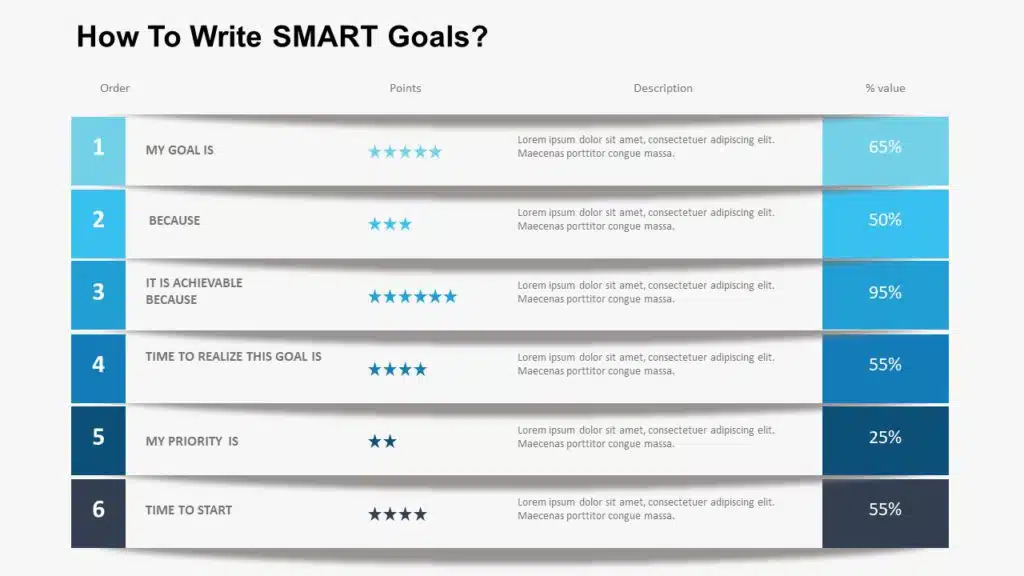
Now you have your Scope statement ready. So, let’s discuss how to write each aspect with examples of smart goals for work.
Specific
While setting up a goal, be specific about what you want to achieve. It is like the mission statement for your goal. To make sure that you are setting up a specific goal, try answering these ‘w’ questions:
Who – Consider who needs to be involved in achieving the goal (this is important when working on a group project).
What – What exactly are you trying to accomplish? Try to write it down in detail.
Which – Determine which resources and skills are required to achieve your goal.
Why – What is the reason for the goal?
Let’s consider some examples of smart goals for work to understand this better
SMART goals examples: “Improve customer satisfaction ratings.”
Explanation: This goal needs to be more specific because it doesn’t clarify how customer satisfaction will be improved or which aspect of satisfaction needs attention.
A more specific goal would be: “Decrease average customer response time for support inquiries from 24 hours to 12 hours by implementing a ticketing system.”
Measurable
You need a parameter or metric to track your progress. Think about the parameters you will consider to determine if you have achieved the goal. It makes a goal more tangible because it allows us to measure our progress. If it’s a project that will take a few months to complete, set some milestones by considering specific tasks and effectively tracking them.
Sometimes, measuring progress is difficult. Managers and employees can work together to identify the most relevant and feasible data sources. Measurements can be quantitative (milestones, money earned, etc.) and qualitative (client testimonials, surveys, etc.).
example of smart goals for work: “Increase website traffic.”
Explanation: While this goal indicates an increase, it lacks a measurable target. A more measurable goal would be: “Increase website traffic by 20% within six months by implementing SEO strategies, content marketing, and social media campaigns.”
Achievable
When framing our goals, we should consider if we have the resources, finance, and skills to achieve the goal we are working on. The goal needs to be challenging yet achievable. It should inspire us to work hard and not discourage us. Think about:
1. How to accomplish the goal
2. If you have the tools/skills needed,
3. If you have the finances required to execute the goal
4. Determine whether the time set to achieve the goal is realistic.
5. Consider taking the team’s input to ensure that the team feels it is achievable.
SMART goals examples Example: “Double our annual revenue within three months.”
Explanation: While ambitious goals are encouraged, this goal may not be realistically achievable within the given timeframe. A more achievable goal might be: “Increase annual revenue by 30% within the next fiscal year through targeted marketing campaigns and expanding into new markets.”
Relevant
Relevance refers to focusing on something that makes sense with your broader business plan. For example, if we want to launch a new program, it should be aligned with the overall business/department objectives. Your team may have the skills and resources to launch a new program. Still, if your business/department is not prioritizing launching the program, the goal wouldn’t be relevant.
Smart goals examples for employees- “Launch a new product line unrelated to our core business.”
Explanation: While launching new products can be beneficial, it may not be relevant if it’s not aligned with the organization’s core objectives or expertise. A more relevant goal would be: “Expand our product line to include eco-friendly alternatives within our existing industry to meet growing consumer demand for sustainable options.”
Time-Bound
Anyone can set goals, but they may fail if they lack a realistic time frame. A target date for deliverables is always recommended to make your goal achievable. People focus on time and act accordingly to complete the tasks before deadlines. Ask yourself questions about the goal deadline and whether the goal can be accomplished within that period. Providing time constraints also creates a sense of urgency and focus. Let’s understand this with smart leadership goals examples. It will help you understand better.
Another smart goals examples for employees – “Improve employee retention.”
Explanation: This goal needs a specific timeframe for completion. A time-bound version would be: “Increase employee retention rate by 15% within the next year by implementing professional development programs, improving work-life balance initiatives, and conducting regular employee feedback surveys.”
Tips To Build Effective SMART Goals
When writing SMART goals, brainstorm with team members on all the aspects of goal setting. The entire team must take ownership of the goals to succeed.
Include your Team: The collective brainstorming and answers will help fine-tune your strategy, ensuring the goals are attainable. It ensures everyone is on the same page to make the most of resources, efforts, and time. It also eliminates the possibility of overlooking issues hindering your team’s efforts toward achieving your goals. Overall, it helps focus and discipline your actions and helps organize everything related to the goal.
Keep it direct & simple: It can take a lot of work to make specific long-term goals that fit this SMART Goals criteria. Break your goals into simple short–term goals if they are too complex. People understand simple and direct things easily.
Write it down: You might be thinking many things, but to remember all of them, you need to write them. You might skip a few points if they are only thoughts. Writing things down always helps and makes you remember things. It helps you write all your smart goals examples for work.
Be flexible: Try not to be hardwired to follow a single track. Be flexible enough to pivot and change your plans to other options if you aren’t achieving your desired results. It’s better to try another method instead of wasting your time on things that aren’t providing results.
Consider feedback: Take input from your team members as well. Ask them for feedback, as it’s always better to have a diverse set of ideas. It will also instill a feeling of inclusion amongst your team members.
SMART Goals Examples For Work
We have also discussed a few Smart goals examples for work to understand this topic better.
for Sales team
You want to increase your profits by selling more. A common goal would be – “Increase Our Profits”. But, this is very general and vague. The right way to define it is explained below:
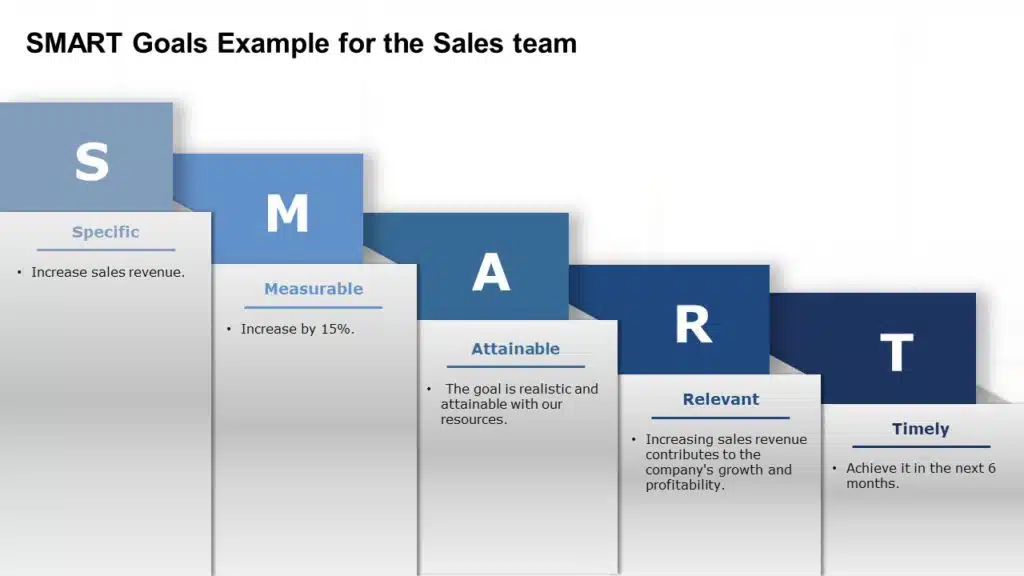
SMART Goal: Increase Monthly Sales Revenue by 15% within the Next 6 Months
Specific: The goal clearly states what to achieve – an increase in sales revenue.
Measurable: The goal is measurable, specifying a 15% increase in sales revenue. You can measure monthly sales revenue by the percentage increase.
Achievable: The goal is realistic and attainable, given the current resources, market conditions, and previous sales data.
Relevant: Increasing sales revenue aligns with the overall objectives of the sales and marketing team and contributes to the company’s growth and profitability. Hence, it’s relevant.
Time-bound: The timeframe is set for achieving the goal within six months. It will push the team to work faster and achieve it in 6 months.
SMART Goals Examples For Work – Operations team
A general goal will be to cut down the company’s costs. But a better approach is to define it through Smart Goals. See the example below to understand this:
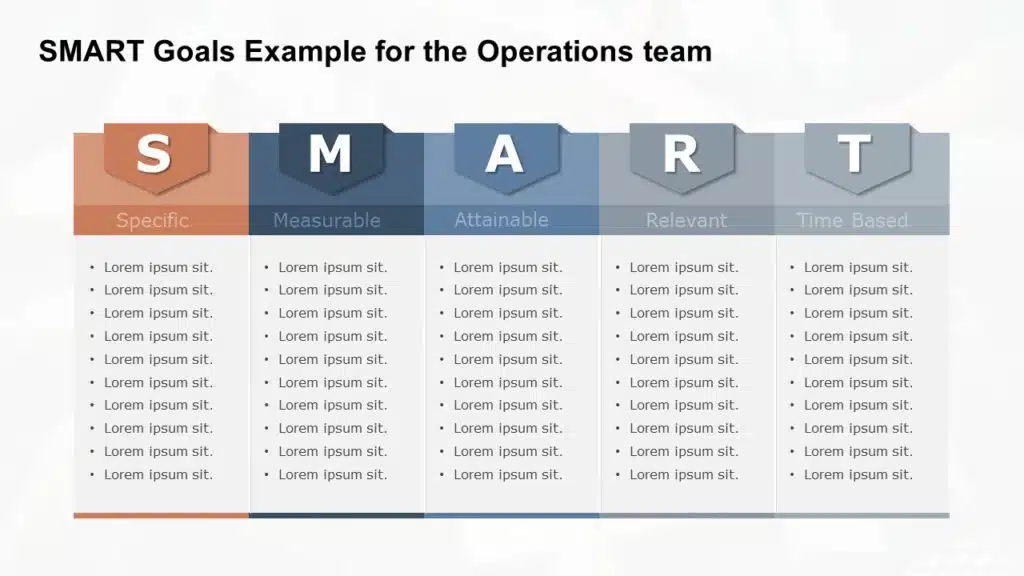
SMART Goal: Reduce Operating Expenses by 10% over the Next Fiscal Year
Specific: The goal clearly describes what to achieve – reducing operating expenses.
Measurable: The goal has a metric to measure – a 10% reduction in operating expenses.
Achievable: The goal is realistic and achievable through careful budgeting, cost-saving initiatives, and efficiency improvements.
Relevant: Reducing operating expenses directly improves the company’s financial health and profitability, aligning with the finance department’s objectives.
Time-bound: The timeframe is set for achieving the goal – over the next fiscal year.
SMART Goals Example for Professionals
We have discussed two smart goals examples for work. Let’s also discuss smart goals examples for employees also.
Businesses and Professionals can also use smart goals for personal development. Let’s say you want to add new skills and update your professional resume. Then, you may set a goal like – I will do a professional course. But there’s a better way.
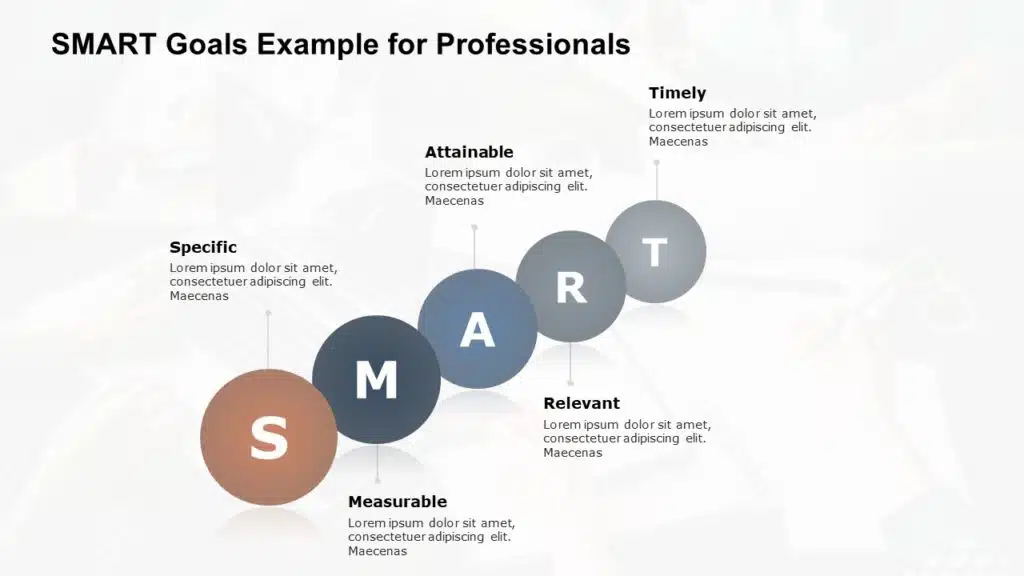
SMART Goal: Enhance Professional Skills by Completing Two Industry-Related Certifications within the Next 12 Months.
Specific: The goal specifies enhancing professional skills by completing two industry-related certifications.
Measurable: The goal can be measured, as it outlines completing two certifications within the next 12 months.
Achievable: The goal is realistic and attainable for professionals seeking to advance their skills and credentials within their industry.
Relevant: Enhancing professional skills through certifications directly contributes to career growth and competence within the industry.
Time-bound: The timeframe is set for achieving the goal within 12 months.
SMART Goals Templates
You must have understood the topic better through SMART goals examples. We have created a few templates to make it easier for you to draft Smart Goal presentations for your business and personal goals. Slideuplift provides templates for multiple PowerPoint Presentations. They are visually appealing and easy to edit. Let’s discuss some of the Smart Goals templates below.
SMART Goals For Business PowerPoint Template
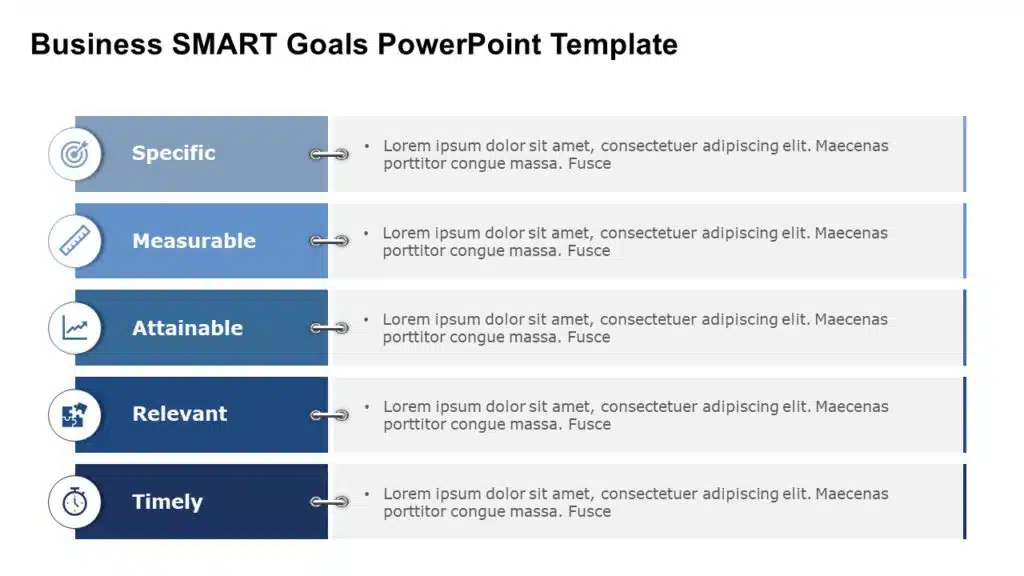
You can use this creative SMART goal template to showcase your business goals in one slide. You can briefly describe and present all five elements of your SMART goals to your teams. Just Download the smart goal presentation template and fill in your content as per your need.
SMART Goals Sticky Notes PowerPoint Template
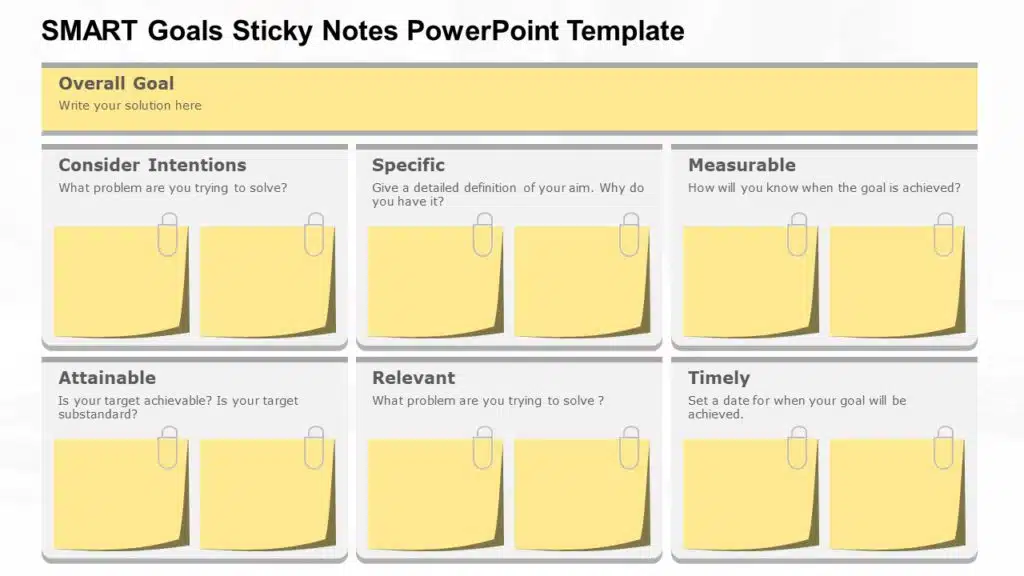
Using this creative SMART goals examples template, you can effectively showcase your goal in a single slide. The best feature of this template is its unique design. It differs from the general themes and styles and lets you showcase your goals through “Sticky notes” Themes. There is an empty sticky note for each element of smart goals, which you can use to write your content. Download the smart goal presentation and use it to draft your goals.
SMART Goals Worksheet PowerPoint Template
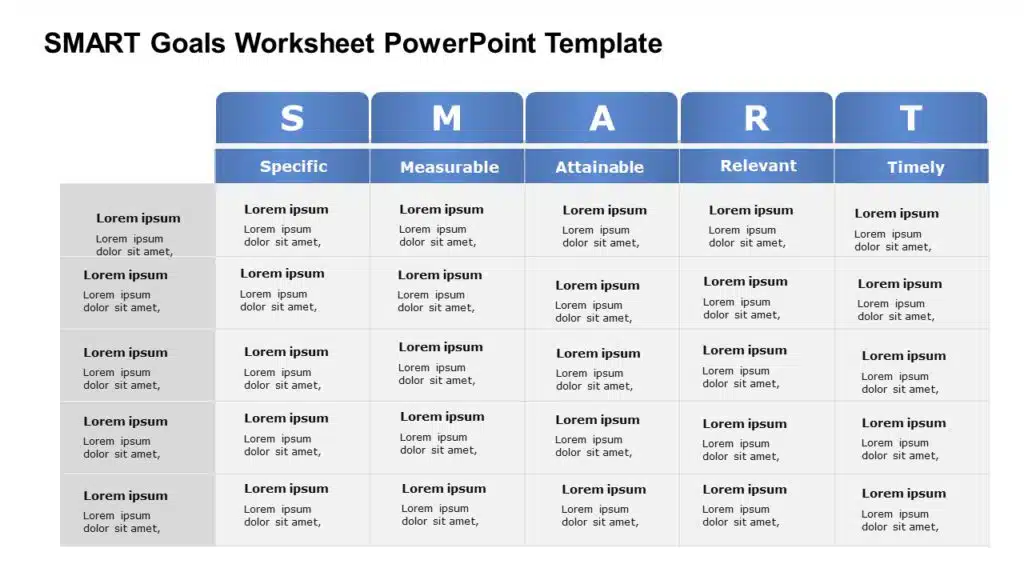
This is a good SMART goals examples with a “Worksheet” theme. It helps you to add multiple goals in a single slide. Effectively present your goal in a single slide using this creative SMART goal template, where you’ll briefly describe all five elements: Specific, Measurable, Achievable, Relevant, and Time-bound. Download the smart goal presentation and start typing your content into the template.
Animated SMART Goals PowerPoint Template
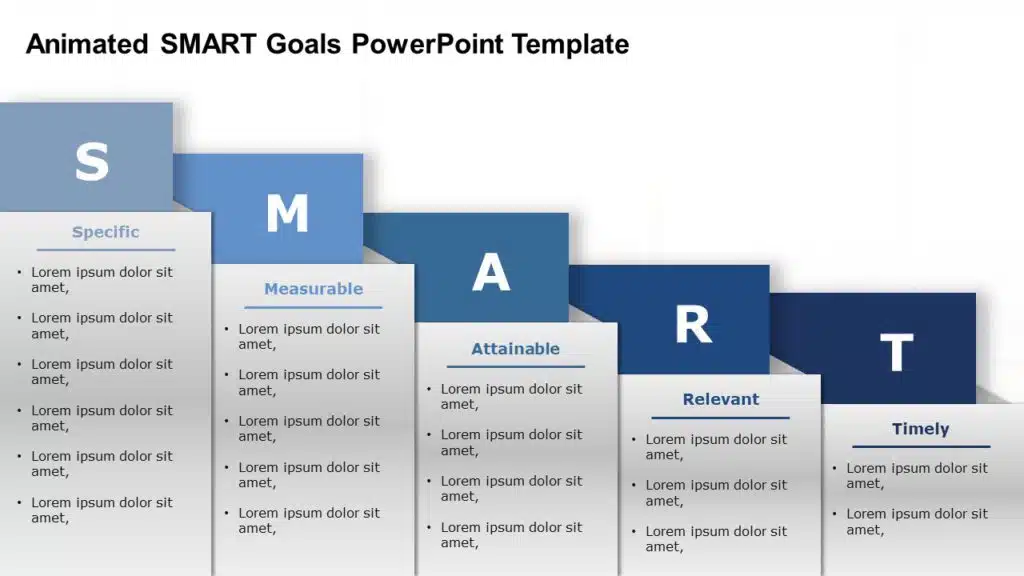
This template has animations, making it more creative and appealing to the audience. Beautiful animations uplift your presentation quality and leave a good impression on the meeting attendees. You can briefly describe and present all five elements of your SMART goals to your teams. Just Download the smart goal presentation Template and fill in your content as per your need.
Conclusion
SMART Goal is an effective method that provides the clarity, focus, and direction you need to achieve your goals. It can also improve your ability to achieve your goal by encouraging you to define your objectives and set a completion date. We have mentioned and explained a few smart goals examples for work. Use SMART goals PowerPoint slides to showcase your business goals to the stakeholders to get consensus and implement the strategy.
FAQs
-
What are SMART goals?
SMART goals are objectives that are specific, measurable, achievable, relevant, and time-bound. They are crafted to offer clear direction and focus for both individuals and organizations.
-
Why are SMART goals important?
SMART goals examples provide a framework for setting objectives that are specific enough to be actionable, measurable to track progress, achievable within realistic constraints, relevant to overarching objectives, and time-bound to create a sense of urgency and accountability.
-
How do I make my goals specific?
To make your goals specific, clearly define what you want to accomplish, who is involved, what resources are required, where it will happen, and why it’s important. This clarity helps in understanding exactly what needs to be done.
-
What does it mean for a goal to be measurable?
Measurable goals involve establishing criteria or indicators for tracking progress and determining when the goal has been achieved. This often involves quantifying aspects of the goal so that progress can be objectively assessed.







